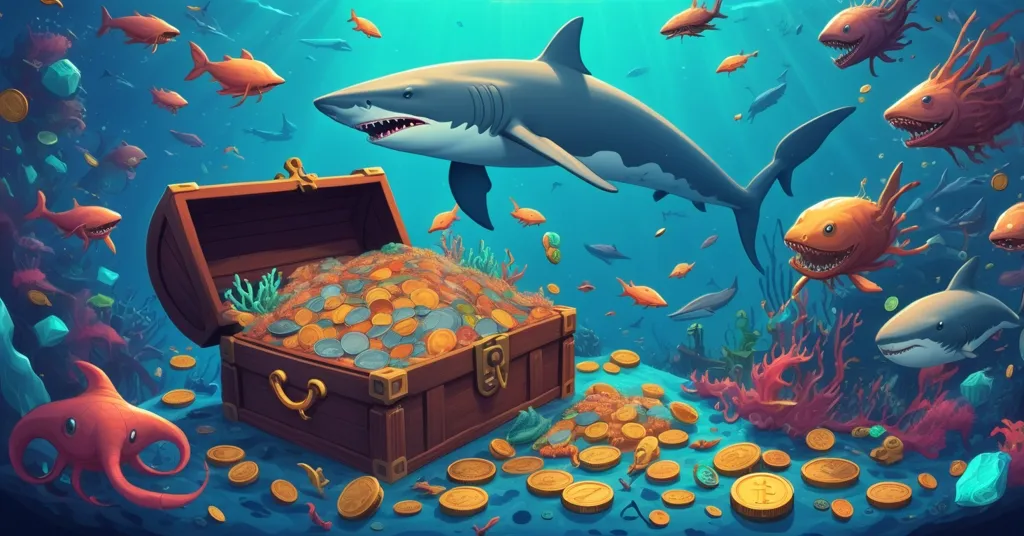Pi Network’s Sea Creature Rankings: Shrimp to Humpback Sparks Hype and Distribution Concerns

Pi Network Sea Creature Rankings: Shrimp to Humpback—What’s Your Status?
Pi Network has sparked a frenzy among its massive user base with a whimsical sea creature ranking system for Pi Coin holders, unveiled by co-founder Dr. Nicolas Kokkalis on X (formerly Twitter). From “Shrimp” to “Humpback,” this viral initiative is stoking community excitement as the project inches toward its long-awaited mainnet launch. But beneath the playful surface, a glaring imbalance in holder distribution raises serious questions about what’s ahead when Pi finally hits the market.
- Viral Rankings: Pi Coin holders classified from Shrimp (<1 Pi) to Humpback (5,000+ Pi) in a community-driven meme.
- Uneven Distribution: 70% of users are Shrimps, yet top 100 wallets hold 96% of the supply.
- Launch Risks: Potential volatility looms as mainnet migration and exchange listings approach.
The Sea Creature Craze: A Clever Community Hook
Imagine logging into your Pi Network app, checking your balance, and discovering you’re a “Shrimp” or maybe a “Shark.” This lighthearted ranking system, introduced by Dr. Nicolas Kokkalis, has taken the Pi community by storm. The tiers are simple yet engaging: less than 1 Pi lands you in the Shrimp category, where roughly 70% of the project’s estimated 50 million users reside. Scale up to 1-10 Pi, and you’re a Crab; 100-500 Pi makes you an Octopus; 1,000-5,000 Pi crowns you a Shark; and if you’ve hoarded 5,000 or more, you’re a mighty Humpback. While not an official metric, this classification has ignited a firestorm of interest, with Pioneers—Pi’s term for its users—bragging, joking, and even ramping up their mining efforts to climb the aquatic hierarchy, as seen in lively community discussions on Reddit.
For those new to the space, Pi Network is a mobile-first cryptocurrency project launched in 2019 by a team of Stanford graduates, including Kokkalis. Unlike Bitcoin, which demands power-hungry hardware for mining, Pi lets anyone earn coins through a smartphone app with negligible energy use. It’s a democratizing idea that’s drawn millions, promising to bring crypto to the masses. However, there’s a catch: Pi Coins currently have no market value. The project operates in a testnet phase—a sandbox for development—meaning no trading or real-world use yet. The goal is a mainnet launch, where the blockchain goes live, and coins can finally be exchanged. Until then, efforts like these sea creature rankings keep the community buzzing with anticipation, turning a long wait into a game of status and identity. For a deeper dive into the project’s background, check out this comprehensive wiki on Pi Network.
Beneath the Waves: The Whale Problem and Centralization Risks
While the rankings are all fun and games, a deeper dive into Pi Network’s ecosystem reveals a troubling undercurrent. Community-sourced data suggests that the top 100 wallets control a staggering 96% of the total Pi Coin supply. Let that sink in—96%. To put it in perspective, that’s like a tiny fraction of shareholders owning nearly all of a company’s stock, leaving the majority with crumbs. Yes, this figure likely includes burn addresses (wallets where coins are sent to be permanently removed from circulation) and liquidity pools (reserves for trading stability). But even accounting for those, the concentration screams “whale territory.” And in crypto, whales—those massive holders—can flip a market upside down with a single transaction, as explored in this detailed wallet distribution analysis.
For a project touting inclusivity through mobile mining, this disparity feels like a betrayal of ethos. Compare it to Bitcoin’s early days, where a handful of miners amassed huge stacks, yet over time, distribution spread out as adoption grew. With Pi, we’re staring at a pre-launch snapshot, and it’s unclear if these top wallets belong to the team for ecosystem growth, early adopters who mined relentlessly since 2019, or speculative hoarders eyeing a quick cash-out. Without audited tokenomics—detailed breakdowns of coin supply and allocation—from the Pi team, we’re navigating in murky waters. If Humpbacks and Sharks dump their holdings the moment exchanges list Pi, the Shrimps could be crushed under a tidal wave of sell pressure, echoing the volatility we’ve seen with altcoins like Bitcoin Cash or Dogecoin in their infancy. This potential for massive token dumps by large holders poses significant risks.
Mainnet Limbo: Delays Testing Pioneer Patience
Speaking of trust, let’s talk about Pi Network’s endless march toward mainnet. Promised as the moment when Pi Coins gain real utility and tradability, this milestone has been teased for years, with no concrete date even in late 2023. Recent updates show progress—KYC (Know Your Customer) verification to combat fraud and wallet migration to prepare for the live blockchain—but bottlenecks persist. Technical hurdles, regulatory scrutiny, or simply perfectionism could be at play, though the Pi team remains frustratingly vague. For a community waiting since 2019, patience is wearing thin, and initiatives like sea creature rankings can only distract for so long. Curious about the latest on this topic? See recent statements regarding mainnet progress shared by community members.
Delays aren’t unique to Pi. Countless altcoins have stumbled through prolonged pre-launch phases, sometimes losing momentum entirely—think of projects like Tezos, which faced legal and internal battles before finally launching. On one hand, caution might ensure Pi Network avoids a botched rollout riddled with bugs or security flaws. On the other, endless postponements risk alienating users who’ve mined for years with nothing tangible to show. If the hype fades before trading begins, even the most loyal Pioneers might jump ship. The question isn’t just when mainnet will happen, but whether Pi can deliver without fracturing its base in the process. For more community insights on launch timelines, explore this discussion on Pi’s market debut status.
Gamification in Crypto: Genius Move or Temporary Distraction?
Zooming out, the sea creature rankings tap into a broader trend sweeping crypto: gamification. From NFT badges to play-to-earn rewards, projects increasingly use game-like mechanics to keep users hooked, especially during downtime or pre-market stages. Pi’s strategy here is savvy—it’s not just about laughs; it’s about loyalty. Labeling someone a Shrimp or a Humpback creates an emotional stake, a badge of honor or a challenge to level up. For a project stuck in limbo, that’s a lifeline to retain millions who might otherwise forget their dormant app.
But there’s a flip side. Gamification can backfire if promises don’t materialize. If mainnet delays drag on or the launch disappoints, cute nicknames won’t quell frustration. We’ve seen this with other tokens—hype-driven communities can turn sour fast when reality bites. Pi’s rankings are building a tight-knit crew, but they’re also inflating expectations. If the team can’t navigate these choppy waters, today’s engaged Pioneers could become tomorrow’s loudest critics.
Scam Alert: Predators Circling the Hype
With viral buzz and a user base of over 50 million, Pi Network is a juicy target for scammers. Fake airdrop schemes, phishing emails, and fraudulent Telegram groups posing as “official” channels are already rampant in the crypto space, and Pi’s hype makes it prime bait. Pioneers, beware: no legitimate Pi team member will ask for your private keys or promise early access to trading for a fee. We’ve seen this playbook before—scammers exploited Dogecoin’s meme-driven surge with fake giveaways, fleecing unsuspecting fans. Stick to verified sources like the official Pi app or website, and treat any “too good to be true” offer as the shark it likely is. For a breakdown of notable holders fueling this hype, take a look at who’s atop the Pi Network rankings.
This isn’t just a warning—it’s a reminder of the dark side of crypto’s accessibility. Projects like Pi, with their low entry barriers, attract dreamers and novices who might not spot red flags. Protecting yourself isn’t just smart; it’s survival in a sea full of predators. If the ranking hype has you checking your wallet, double-check who’s messaging you about it.
Pi’s Place in the Crypto Revolution: A Bitcoin Maximalist Lens
As champions of Bitcoin and decentralization at “Let’s Talk, Bitcoin,” we can’t help but squint at yet another altcoin promising to reinvent finance. Pi Network’s mobile-first approach is intriguing—potentially onboarding millions of unbanked folks to crypto through a simple app is no small feat. It fills a niche Bitcoin doesn’t touch, accelerating adoption in a way that aligns with our “effective accelerationism” ethos of pushing tech forward, fast. If Pi pulls it off, it could earn a grudging nod of respect, even from BTC maximalists like us. For a detailed comparison, see this analysis of Pi’s mobile mining versus Bitcoin’s model.
Yet skepticism runs deep. Centralization of 96% of the supply in a handful of wallets clashes hard with the decentralized spirit we live for. Bitcoin had its whale issues early on, but its pseudonymous creator and open ledger offered a trustless foundation Pi hasn’t matched. Add in years of delays and opaque tokenomics, and Pi risks looking like a gimmick rather than a revolution. Can it carve out a lasting role in this financial upheaval, or will it flounder under whale weight and broken promises? Only the mainnet launch will tell, and we’re not holding our breath. For now, whether you’re a Shrimp or a Humpback, the real test is if Pi can swim with the big fish without sinking the little ones.
Key Questions and Takeaways
- What’s behind Pi Network’s sea creature ranking system?
It’s a playful initiative by co-founder Dr. Nicolas Kokkalis to boost community engagement, giving users quirky titles from Shrimp to Humpback based on their Pi Coin holdings. - Why are most users stuck as Shrimps?
Around 70% hold less than 1 Pi Coin, often due to being new to mining or limited app usage over time. - How might holder distribution impact Pi Coin’s value post-launch?
With 96% of supply in the top 100 wallets, whales could trigger massive price swings if they sell off large chunks early on exchanges. - Are mainnet delays a dealbreaker for Pi Network?
Not yet, but prolonged waits since 2019 test community trust—delays could signal caution or incompetence, depending on the eventual rollout. - How does Pi’s mobile mining compare to Bitcoin’s model?
Pi uses a smartphone app for low-energy mining, aiming for accessibility, while Bitcoin relies on power-intensive hardware, prioritizing security over ease of entry. - What’s the risk of gamification hype like these rankings?
It builds loyalty now, but if mainnet disappoints or delays persist, user excitement could turn to frustration or abandonment. - How can users stay safe amid Pi Network’s viral buzz?
Watch for scams—avoid fake airdrops or phishing attempts promising free Pi or early trading access, and stick to official channels for updates.



